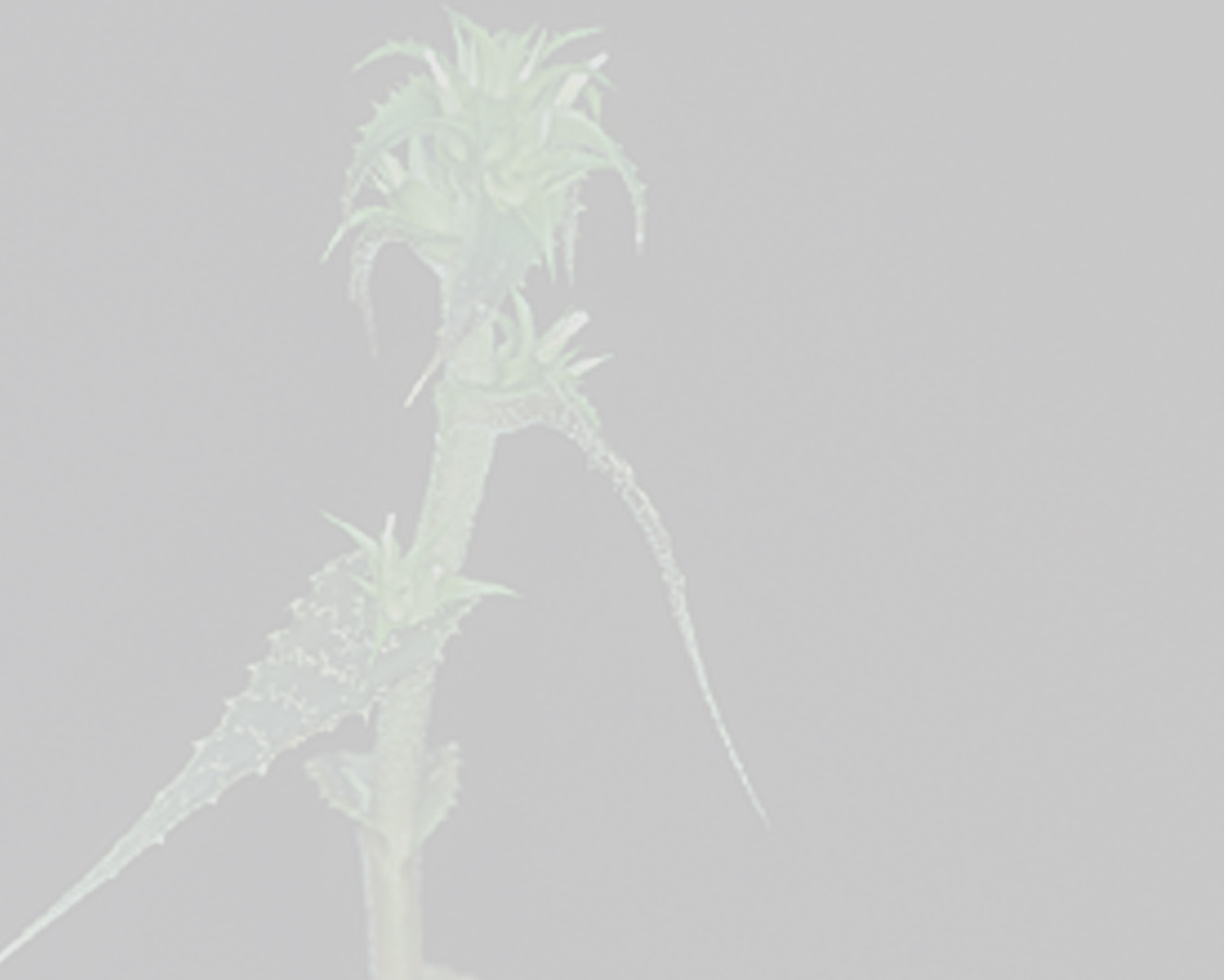

 Orthophytum toscanoi subsp. atropurpureum Braun & Esteves[as Orthophytum toscanoi subsp. atropurpureum Braun & Esteves]
Orthophytum toscanoi subsp. atropurpureum Braun & Esteves[as Orthophytum toscanoi subsp. atropurpureum Braun & Esteves]Diagnose: —Recedit a typo ssp toscanoi bracteis floriferis et sepalis atro-purpureis. Subspecies toscanoi adhuc noto est in Bahia, sed ssp atropurpureum distributa est in Minas Gerais. Observations: —Some new finds conjure unpleasant memories. A case in point takes us back to 1983, when the late Leopoldo Horst and Pierre Braun were venturing around eastern Brazil. In those days travel in the region was not as comfortable as it is today. The dirt roads were in ruins, and small villages with poor infrastructure brought new surprises on a daily basis. One evening we crossed the border from southern Bahia in Minas Gerais,
and by sundown we had reached a small settlement in northern Minas Gerais. We were happy to find accommodation in a primitive guest house that night, and the friendly woman who ran the place offered us some kind of cold scrambled egg concoction before we went to bed. Having had nothing to eat all day, we gorged all of what she offered, but we were to pay bitterly. Over the next few days we became very sick with what turned out to be a amoebic dysentery, a situation that culminated in a hospital stay in Diamantina a week or so later.
Already feeling a bit queasy, the next day we abstained from breakfast (which appeared to be the same stuff we'd eaten the evening prior, and started off early in the morning. Not far away we passed some dry caatinga vegetation harboring several columnar cacti and stopped for a more detailed inspection. Besides several well-known cactus species, we discovered a dwarfish new subspecies of Arrojadoa dinae, later described as ssp. nana, and a whitish Orthophytum, which was collected under the number Braun 417a. Leopoldo sent some plants to Germany for identification by our friend Werner Rauh at the University of Heidelberg.
We were busy studying the plants, crawling on all fours over the soil and rocks under dense, barbed-wire bushes, when suddenly we heard the loud hum of an approaching helicopter, but here in the wild so far from civilization?! It was almost too late when
we realized that we had been targeted by a colony of wasps. These were horrific creatures, with giant, 5 cm long, steel-blue bodies. Instinctively we jumped up and made a beeline to the car, failing to notice that we had left our film and notes in the field. For years nothing became of the plant we had found. Leopoldo died in 1987, and Werner Rauh never sent word of the plants we'd escaped with. Werner died in 2000, and the plants likely did not fare any different.
Though it became more and more obvious that this white Orthophytum was an undescribed species, only in 1999 were Eddie and Pierre able to revisit the type locality. How irritating that the plants we collected on that trip as Braun 2366 died before flowering in cultivation! At last in 2002 we returned at the right moment to find flowering plants in habitat (Braun 3615).
One year later we saw Elton Leme’s publication of Orthophytum toscanoi from a record collected by Antonio Luiz Toscano de Brito in 2000 at Poco da Moca, Cordeiros, in the state Bahia. Though this is a more northern habitat, and the blades of
O. toscanoi have prominent dentate margins (like a coarse saw blade), his description closely matched our plant, and we gave up hope of scoring a new species description. But, over the last few years we have observed a significant difference in our
cultivated plants from Minas Gerais. Their inflorescences have dark reddish floral bracts and sepals, while those of O. toscanoi are green.
Habitat photos we made of these plants in flower confirmed our greenhouse observation: there the flower bracts and sepals appeared purple – it was amazing that we had failed to notice or fully appreciate this distinguishing feature at the time.
So, contrary to our position published a few years ago, we no longer harbor any doubt that our plant from Minas Gerais is not only "a southern population of the same species," but should rather be considered a distinct subspecies. In two of our recent publications we discussed this plant under the name given by Leme, O. toscanoi. Here
we dub the southern form from Minas Gerais subspecies atropurpureum ,for its dark reddish floral bracts and sepals, which distinguish the sub-species from the type.
Back in 1983 the whole region where this plant occurs was covered by dense, endless caatinga forest. We were able then to inspect many similar habitats, but we were never successful at locating other populations. Today nearly the entire region has been deforested and no longer bears any original vegetation except in rocky spots, changes so dramatic that even the search for similar habitats now meets with failure. Fortunately the type locality appears to be safe since several rocky cliffs there prohibit agricultural use.
Unfortunately the plants appear to be difficult in cultivation. The rosettes should be kept in large shallow pots that can accommodate a horizontal root system. Sandy soil seems preferred. In summer they appreciate humidity and winter temperatures should not fall below about 10° C. Though plants in habitat grow more or less shaded, in the green-house full sunshine is needed for plants to develop their silvery-white coating.
Distribution: Brasilia, Minas Gerais septentrionalis, in vicinitate Ribeirao da TabuaEdited from (9---0-2019): Braun & Esteves 2010. (protologue) Succulent and Xeromorphic Bromeliads of Brazil - PART 7 Orthophytum toscanoi ssp atropurpureum .